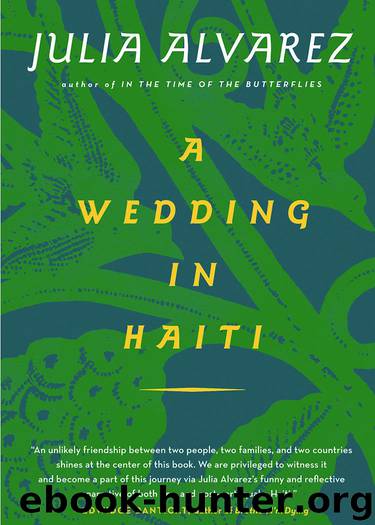A Wedding in Haiti by Julia Alvarez

Author:Julia Alvarez
Language: eng
Format: mobi, epub
Publisher: Algonquin Books
Published: 2012-01-20T22:00:00+00:00
Wolves on both sides of the door: a very brief history of Haiti
The wolf at Haiti’s door had been there long before the January earthquake.
For years we’d been hearing the sad statistics: Haiti is the poorest nation in the hemisphere, one of the poorest in the world. What happens when a natural disaster occurs in a country ill prepared to survive it? The answer was all around us in the days following the earthquake, televised scenes to break the heart and add our own emotional and moral rubble to the dust and rubble of what was left of Haiti’s capital.
And the saddest part was that it was avoidable, not the earthquake itself, of course, but what had happened as a result of it. No matter how the facts were spun and the beads strung, this was not a story of a natural disaster. It was also not a story of a cursed nation whose freedom had been acquired by making a pact with the devil, as Reverend Pat Robertson unbelievably and heartlessly pronounced the day after the earthquake. It was a poverty story, a story of badly constructed buildings, poor infrastructure, and terrible public services. Just as a point of comparison: an earthquake of similar magnitude in the Bay Area in California in 1989 killed sixty-three.
How can this be? Haiti, the poorest country in the hemisphere? One of the poorest in the world? If you took a time traveler from the mid-eighteenth-century Caribbean and plopped him down in today’s Haiti, he would not believe this was the same country. Saint-Domingue, as it was then known, was the world’s richest colony, the Pearl of the Antilles. (Ironically, Santo Domingo next door was a destitute little colony, having been virtually abandoned by Spain for its richer, gold-laden viceroyalties in Mexico and Latin America.) In the hundred years after France acquired the western third of the island from Spain in 1697, Saint-Domingue was producing two-thirds of the world’s coffee, almost half of its sugar, large portions of its cotton, indigo, and cocoa—in short, its exports accounted for one third of France’s commerce. And the fuel that powered this enormously lucrative, money-making machine was human slavery, upward of five hundred thousand enslaved West Africans, “owned” and overseen by forty thousand white Frenchmen.
Again, how can this be? How can a small fraction of a population enslave half a million people, who outnumbered them at least ten to one? In a word, terror. If we were to send a traveler from our own time back to Saint-Domingue to check out how the plantation system worked (I volunteer Pat Robertson for the mission), what a tale of horror he would tell.
Even by the standards of the day, conditions on those plantations were jaw-droppingly brutal. Field hands forced to wear masks to prevent them from eating sugarcane; recalcitrant slaves filled with gunpowder and blown to pieces. In his book on Haiti, The Immaculate Invasion, Bob Shacochis quotes a journal entry by a German traveler who was horrified when the wife of his colonial host ordered her cook pitched into the oven for a mistake in the kitchen.
Download
This site does not store any files on its server. We only index and link to content provided by other sites. Please contact the content providers to delete copyright contents if any and email us, we'll remove relevant links or contents immediately.
| Actors & Entertainers | Artists, Architects & Photographers |
| Authors | Composers & Musicians |
| Dancers | Movie Directors |
| Television Performers | Theatre |
Cecilia; Or, Memoirs of an Heiress — Volume 3 by Fanny Burney(30937)
Cecilia; Or, Memoirs of an Heiress — Volume 2 by Fanny Burney(30892)
Fanny Burney by Claire Harman(25787)
We're Going to Need More Wine by Gabrielle Union(18077)
Plagued by Fire by Paul Hendrickson(16639)
Cat's cradle by Kurt Vonnegut(13874)
Bombshells: Glamour Girls of a Lifetime by Sullivan Steve(13113)
All the Missing Girls by Megan Miranda(12755)
Leonardo da Vinci by Walter Isaacson(11909)
4 3 2 1: A Novel by Paul Auster(11053)
Adultolescence by Gabbie Hanna(8147)
The remains of the day by Kazuo Ishiguro(7558)
Note to Self by Connor Franta(7025)
Diary of a Player by Brad Paisley(6867)
Giovanni's Room by James Baldwin(5884)
What Does This Button Do? by Bruce Dickinson(5530)
Recovery by Russell Brand(4567)
Born a Crime by Trevor Noah(4513)
The Kite Runner by Khaled Hosseini(4455)
